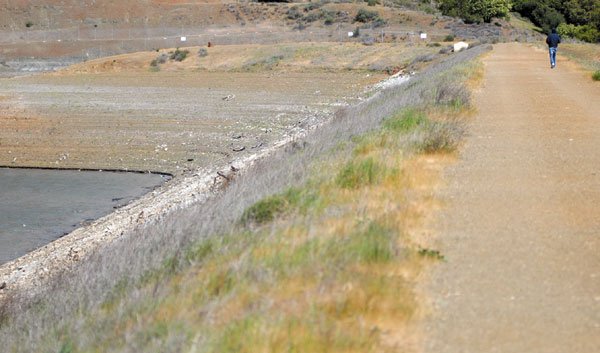Gilroy
– The water district is racing to save some of the region’s most
threatened fish before expected drought conditions devastate
wildlife in Uvas Creek.
Gilroy – The water district is racing to save some of the region’s most threatened fish before expected drought conditions devastate wildlife in Uvas Creek.
The plan to save what could amount to hundreds of mature steelhead trout hinge on manipulating Mother Nature. For the next four weeks, the Santa Clara Valley Water District will release surges of water from Uvas Reservoir in hopes of simulating late spring conditions, when creeks slow after winter storms and fish leave spawning areas and travel down the Pajaro River to the Monterey Bay.
“A lot of fish reared in the creek last year and now we want to get them out to the ocean,” said Jonathan Ambrose, a biologist with the National Marine Fisheries Service in Santa Rosa who worked with the water district to devise the plan.
“Steelhead typically head for the ocean in April and May,” he said. “They key in on when the flows start to recede and then they really start moving. By sending a pulse flow down, when it tapers off a bit, that’s their cue … We believe most of them will move out. We’re not going to get every single one of them out of there, but the key is to get the bigger ones out because their chance of surviving in the ocean are much greater.”
Extremely low water levels threaten to cut off passage to the ocean for adult steelhead who have spawned and for younger ones that have spent a year or two maturing in Uvas Creek. Unlike salmon, another anadromous fish, steelhead do not die after spawning and can return multiple years to lay eggs. The fish is listed as a threatened species – one step shy of endangered.
The move to save the fish – which involves above-average water releases – comes as Uvas Reservoir stands at one of its lowest levels in 20 years, according to Jeff Micko, operations manager for the water district. He said that at this time last year, the reservoir held its maximum of 10,000 acre feet of water – the equivalent of a football field with nearly two miles worth of water stacked on top. The water level now stands at a quarter of that amount, and officials predict it will drop to just 400 acre feet by December.
The district has plenty of drinking water stored in the ground as well back-up supplies from Shasta Lake and the Central Valley, Micko added. He said that after releasing four 72-hour “pulses” of water in coming weeks, the district will scale back releases from the dam to a trickle of just 3.5 acre feet per day.
“It’s just the nature of the weather in California that we go through wet periods and dry periods,” Micko said. “We just have to do our best to operate the reservoirs for water supply and fisheries and flood management through all those conditions. This kind of year happens about one out of 20.”
The dry spell arrived at an especially bad time for Ambrose and other environmental regulators, who have been working with the water district to boost steelhead populations.
During the past few years, officials have released higher levels of water from the reservoir during summer months. By doing so, officials hoped to stretch the window of time in which steelhead can return to the ocean. Normally, the fish head downstream before Uvas Creek dries up south of Christmas Hill Park.
The experiment helped increase the number of steelhead, Ambrose and other officials said, but at the expense of endangering other wildlife along Uvas Creek. This year, due to the need to scale back on releases from Uvas Reservoir, the creek will stop flowing by the bridge off Hecker Pass Highway, nearly a mile shy of its normal length during summer.
A water district press release warns of “a probable loss of wildlife along creeks” fed by five of the county’s 10 reservoirs – Uvas, Chesbro, Almaden, Guadalupe and Stevens Creek.
Despite the near-drought conditions, officials are not second-guessing the strategy of releasing higher levels of water from Uvas Reservoir.
“This is so difficult to plan because it’s all a matter of percentages,” Ambrose said. “Ninety percent of the time this works and we have enough water the following year. But this is one of those years … It’s kind of a roll of the dice and it’s unfortunate.”













